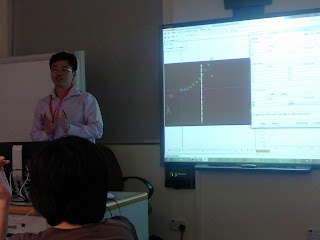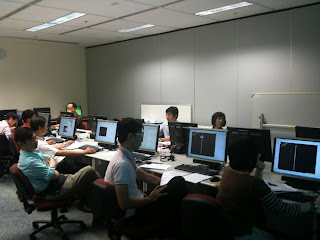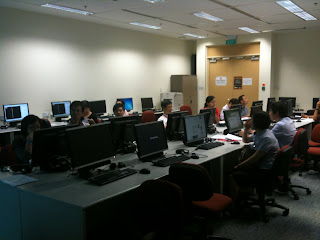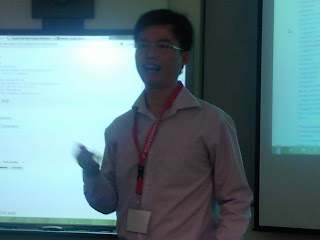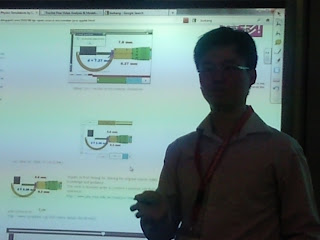http://weelookang.blogspot.sg/2011/05/video-analysis-and-modeling-tool-for.html
Briefing Document: Video Analysis and Modeling Tool for Physics Education
1. Overview
This document summarizes the key aspects of a workshop and initiative focused on integrating technology, specifically video analysis and modeling tools, into physics education. The primary resource is a web page detailing a presentation by Lee Tat Leong and Wee Loo Kang at the 4th Redesigning Pedagogy International Conference in 2011. The workshop highlights the use of the free "Tracker" software to enhance student learning through hands-on analysis and modeling of real-world physics phenomena. The broader context includes a strong push for the integration of Information and Communication Technology (ICT) in Singapore's educational system. The materials are open educational resources (OER) under a Creative Commons license, emphasizing a collaborative and sharing ethos.
2. Key Themes
- ICT Integration in Education: The underlying theme is the purposeful and meaningful integration of ICT into physics teaching. This aligns with Singapore's Ministry of Education (MOE) initiatives, particularly the ICT Masterplans, which emphasize self-directed and collaborative learning. As stated in the abstract, "In 1997, MOE started the first ICT Masterplan as part of our Thinking Schools Learning Nation vision. As part of the third Masterplan for ICT in 2010, this workshop seeks to deepen the meaningful integration of ICT in the learning of physics through developing students' competencies for self-directed learning and collaborative learning."
- Self-Directed Learning: A core goal is to empower students to become self-directed learners. The workshop aims to provide teachers with the tools and skills to facilitate student-driven inquiry. The tools "...allows students to engage in self-directed learning beyond the constrain of the classroom."
- Hands-On Learning: The approach emphasizes hands-on learning experiences where participants actively engage with the software and analyze real-world examples. The workshop is described as a “hands-on session” focused on practical application. Participants “will learn how to perform video analysis on the kinematics of bouncing ball and video modeling a simple projectile motion.”
- Use of Open Educational Resources (OER) and Open Source Physics (OSP): The use of freely available tools like Tracker highlights the OER and OSP movement. This enables mass deployment at minimal cost, as highlighted in the abstract, "...the video analysis and modelling tool is a free software and allows mass deployment in a short time at minimal cost." There is a strong emphasis on sharing resources, which aligns with the Creative Commons license.
- Video Analysis and Modeling: The primary focus is on the use of video analysis and modeling as powerful pedagogical tools. Learners are able to compare textbook theories with real-world motion by analyzing the motion of objects captured on video.
- Community of Practice: The workshop is presented as a part of a larger community-of-practice for physics teachers in Singapore, encouraging educators to learn and collaborate with each other. The document encourages educators to “go to ICT Connection Learning Team and learn together, advancing the professionalism of educators in Singapore”.
3. Important Facts and Ideas
- The "Tracker" Software: The central tool is "Tracker," a free video and image analysis software with dynamic modeling capabilities developed by Prof. Doug Brown. This allows learners to analyze and compare real-world mechanics phenomena with textbook theories by observing object motion in video footage. The software enables the comparison of dynamical models with real-world motion.
- Workshop Format: The workshop was an interactive session designed to familiarize participants (teachers) with the use of Tracker in physics education. Participants were expected to bring their own laptops with the necessary software preinstalled (Java Runtime Environment, QuickTime 7, and Tracker).
- Specific Applications: The workshop included hands-on activities such as video analysis of a bouncing ball and video modeling of projectile motion.
- Conference Context: The workshop was part of the 4th Redesigning Pedagogy International Conference, indicating its significance within the educational community in Singapore.
- Authors and Presenters: The workshop was led by Lee Tat Leong and Wee Loo Kang from the National Institute of Education (NIE) in Singapore.
- Resources: The page provides access to various supplementary resources, including worksheets created by the presenters (e.g., Loo Kang's worksheet on kinematics of a bouncing ball), YouTube videos demonstrating physics concepts, and links to the Tracker software download. There are many links to related projects and initiatives, demonstrating a larger community and ecosystem of resources.
- Levels: The materials were targeted at the secondary level, as indicated in the workshop abstract which mentions “Level: Secondary.”
- Keywords: The provided keywords are “Information Technology and Education” and “Science Education,” highlighting the focus on technology and physics learning.
- Cost-Effective: As a free and open-source software, it's highlighted that Tracker provides a cost effective solution to mass deploy this technology across education facilities.
- Diverse Range of Simulations and Tools Beyond the focus on Tracker, the page also provides access to many simulations, models, and tools ranging across math and science disciplines. This includes, for example: "Three States of Matter JavaScript HTML5 Applet Simulation Model," "Double Pendulum HTML5 JavaScript Simulation Model," "Young Double Slit or Single Slit or Multiple Slit Diffraction JavaScript HTML5 Applet Simulation Model"
- Community Driven Effort The vast range of materials and projects demonstrates that the site is maintained and contributed to by numerous different educators.
4. Quotes from the Original Source
- "Through this workshop, teachers will develop the capacity to deliver ICT-enriched learning experiences for students to become self-directed and collaborative learners."
- "The Tracker Video Analysis and Modeling Tool is a video and image analysis tool with dynamical modeling. Learners can analyze and compare real world mechanics phenomena with textbook theories through the motion of objects in a video."
- "The tool also allow learners to develop simple to complex dynamical models and the behavior of the model can be compared directly with that of the real-world motion."
- "For informal community of practice of physics teachers, go to ICT Connection Learning Team and learn together, advancing the professionalism of educators in Singapore."
5. Conclusion
The source document demonstrates a strong commitment to using technology to enhance physics education in Singapore. The emphasis on free and open-source tools, hands-on learning, and the development of self-directed learners aligns with contemporary educational best practices. The workshop represents a crucial step in empowering educators to integrate ICT into their teaching and support student learning beyond traditional classroom settings. The associated materials provide a wealth of open resources that highlight the importance of the community of practice this project has developed.
Video Analysis and Modeling Tool for Physics Education by Lee TL and Wee LK @NIE sg 4th Redesigning Pedagogy International Conference 2011 Day 3 (1 June 2011) 15:00-16:30 Compt Lab 7B NIE2-02-02B
new available now
http://conference.nie.edu.sg/2011/papers_pdf/WOR074.pdf
Tracker by Prof Doug Brown
Download Tracker 4.05 installer for:
Resources by teachers
Loo Kang's workheet on kinematics of bouncing ball
Loo Kang's YouTube video http://www.youtube.com/watch?v=HfnXBDOhGE0
Tat Leong's worksheet IPSG on kinematics of bouncing basketball
Tat Leong's worksheet Redesign Pedagogy on kinematics of bouncing basketball
Joo Liak's worksheet for sec 2 students remixed from Loo Kang's worksheet
Loo Kang's worksheet on Kinematics of a Ball thrown up with air resistance originally intended for use by HCI
Loo Kang's YouTube video Ball vertically projected up without air resistance video capture
http://www.youtube.com/watch?v=yvJJU2cPeMs
Loo Kang's YouTube video Ball vertically projected up with air resistance video capture
http://www.youtube.com/watch?v=PGZsH6zfMxc
Simulation on Ball bouncing Ejs Open Source Bouncing Ball with Drag Java Applet
Jimmy Goh's worksheet on Projectile motion
Tracker Free Video Analysis for Physics Education by Douglas Brown & Youtube PD by lookang
http://www.archive.org/details/TrackerFreeVideoAnalysisForPhysicsEducationByDouglasBrownYoutubePd
View thumbnails by http://www.archive.org/
Tracker Free Video Modeling for Physics Education by Douglas Brown & Youtube PD by lookang
http://www.archive.org/details/TrackerFreeVideoModelingForPhysicsEducationByDouglasBrownYoutubePd
View thumbnails by http://www.archive.org/
Presentation Session @ 4th Redesigning Pedagogy International Conference 2011, 30 May - 1 June 2011
Dear Presenter
Hope this email finds you well.
Thank you once again for your participation at the 4th Redesigning Pedagogy International Conference, which will be held from 30 May to 1 June 2011.
The detailed programme of the conference has been up on our website a few weeks ago. You may refer to http://conference.nie.edu.sg/2011/info/detailedprogramme.php. We hope that your preparation for the session is going on well.
We are pleased to remind you on the details of your session:
Format of Presentation: WORKSHOP
Abstract ID : WOR074
Title : Video Analysis and Modeling Tool for Physics Education
Strand : Science Education
Presentation Day : Day 3 (1 June 2011)
Presentation Time : 15:00
Duration : 85 min, including Q&A (another 5 min is buffered for movement of participants from one session to the next)
Location : NIE3-01-TR28
======= Formats of Presentation ========
Paper
A Chair (typically the last presenter of the session) will moderate the time allotted for each presenter.
Workshop
An interactive presentation involving members of your audience.
Symposium
Presentation of 2 or more thematic papers, with a Chair and sometimes Discussant.
Special session
Presentation to showcase new practices in education
===================================
Presentation Slides & documents
Presentation documents (slides & handouts) should be prepared and saved in a USB thumb drive. If you intend to produce hard copies for the audience, please print 20 sets for participants at your own cost.
Standard Equipment
The standard equipment available in all tutorial rooms and lecture theatres are:
Desktop (Windows) computer with DVD/CD-ROM function and LCD projector. A VGA port is provided for notebook connections to the LCD projector. Wall mounted white board (markers will be provided)
If you need any other equipment for your presentation, please email the secretariat no later than 20 May 2011 (Friday), and we will do our best to meet your requirements.
Reporting Time
Please be at the presentation venue at least 15 min before your presentation start time.
Full Paper Submission (optional)
If you wish to submit a full paper for the conference, please note that the deadline is 6 June 2011 (Monday). Please log into the system to upload your full paper. Full paper submission guidelines can be found at http://conference.crpp.nie.edu.sg/2011/downloads/guidelines_paper_submission2011.doc. Please note that full papers will only be uploaded to the conference website and made available to the conference participants after the conference.
We look forward to meeting you at the conference.
Sincerely,
Jaslyn Tan
Conference Secretariat
4th Redesigning Pedagogy International Conference 2011
30 May - 1 June 2011 :: Singapore
c/o E-Quezt Concierge Pte Ltd
167 Jalan Bukit Merah #06-12 SR 21 Tower 4 Singapore 150167
Tel: (65) 6271 2453 Fax: (65) 6271 2439
Email: This email address is being protected from spambots. You need JavaScript enabled to view it.
Website: http://conference.nie.edu.sg/2011/
more photo
| Abstract ID | : | WOR074 |
| Status | : | Pending |
| Title | : | Video Analysis and Modeling Tool for Physics Education |
| Strand | : | Science Education, IT in Education, Teacher Professional Development |
| Level | : | Secondary |
| Keyword(s) | : | Information Technology and Education, Science Education |
| Author(s) | : | LEE Tat Leong, WEE Loo Kang |
| Abstract | : | Rationale: In 1997, MOE started the first ICT Masterplan as part of our Thinking Schools Learning Nation vision. As part of the third Masterplan for ICT in 2010, this workshop seeks to deepen the meaningful integration of ICT in the learning of physics through developing students' competencies for self-directed learning and collaborative learning. Through this workshop, teachers will develop the capacity to deliver ICT-enriched learning experiences for students to become self-directed and collaborative learners. The experience that they will get will allow them to kickstart their students' self-directed learning journey. In addition, the video analysis and modelling tool is a free software and allows mass deployment in a short time at minimal cost.
|
FAQ: Video Analysis and Modeling in Physics Education
- What is the Tracker Video Analysis and Modeling Tool, and what does it do?
- The Tracker Video Analysis and Modeling Tool is a free software that allows students to analyze real-world mechanics phenomena by examining the motion of objects in videos. It also enables learners to create dynamical models, compare these models with real-world observations, and explore physics concepts outside the confines of a traditional classroom setting. Essentially, students can use video recordings of experiments to extract data about motion and compare that data with computer generated simulations.
- How can teachers use the Tracker Tool to enrich physics learning?
- Teachers can use Tracker to provide ICT-enriched learning experiences, empowering students to become self-directed and collaborative learners. The hands-on nature of video analysis and modeling allows students to actively engage with the content, visualize abstract concepts, and develop a deeper understanding of physics. It enables them to go beyond traditional textbook learning and engage with dynamic, real-world phenomena. The tool supports inquiry-based learning, allowing students to explore physics phenomena and compare their findings with simulations.
- What are some examples of physics topics that can be explored with the Tracker tool?
- The Tracker Tool is versatile and can be applied to various physics topics, including kinematics (the study of motion) such as bouncing ball motion and projectile motion. Students can analyze the kinematics of a bouncing ball with or without air resistance, projectile motion, explore energy principles with simulations of pendulums and bouncing objects. Furthermore, concepts like circular motion, collisions, and even more abstract ideas like the behavior of light can be investigated using the tool's modeling capabilities.
- What is the connection between Tracker and Open Source Physics?
- The Tracker tool is aligned with the principles of Open Source Physics, which emphasizes the use of freely available educational resources to enhance teaching and learning. Tracker is freely available, allowing for mass deployment in educational settings. Furthermore, the related simulations and applets are part of a larger collection of open source resources that focus on physics learning and instruction.
- What are the key benefits of using video analysis and modeling in physics education?
- Video analysis and modeling allow for a more engaging and interactive learning experience. By comparing real world observations with theoretical models, students can better conceptualize the application of physics theories. The approach fosters self-directed learning, allows for exploration beyond classroom limitations, and encourages collaborative activities among students. It also makes abstract physics concepts more accessible and concrete through visual representation.
- What is the role of modeling in the context of using Tracker?
- Modeling allows students to create and test their own dynamic models within the Tracker software, comparing these models with real-world data derived from their video analysis. This enhances students' understanding of physical phenomena, their ability to construct and evaluate scientific explanations, and the nature of model building and refinement. It allows students to see how physics theories predict and describe actual motion, and makes the learning more authentic.
- What is the Easy JavaScript/Java Simulations (EJS) tool, and how is it related to video analysis?
- Easy Java/JavaScript Simulations (EJS) is an authoring and modeling tool that is often used in conjunction with Tracker. EJS allows for the creation of interactive simulations which students can compare with their video analysis data collected in Tracker. These simulations can help bridge the gap between theoretical models and real-world experiments. EJS, together with the Tracker video tool, provides a comprehensive suite of software for physics education.
- How does the use of Tracker and related tools promote teacher professional development?
- Workshops and communities of practice focused on these tools help educators advance their professionalism. Teachers learn how to integrate ICT effectively into their curriculum and use open-source tools to create engaging and rigorous learning activities. Educators can collaborate and develop and share resources via online forums to further their knowledge and refine their classroom approaches.



